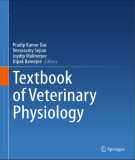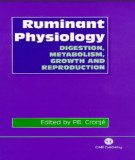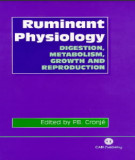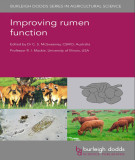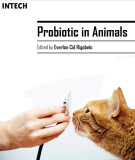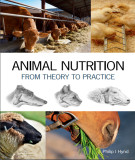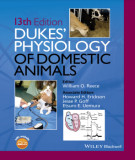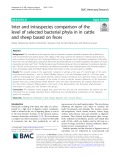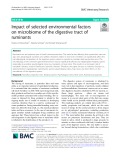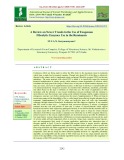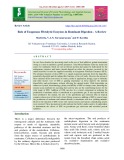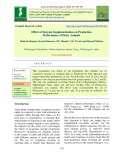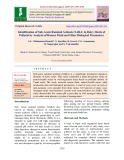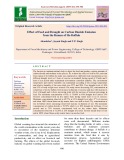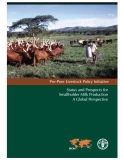
Ruminant digestion
-
Part 1 book "Textbook of veterinary physiology" includes content: Veterinary physiology - Past, present, and future perspective; cellular and molecular physiology; action potential; hematology; immune system - cardiovascular system; physiology of respiration; fluid and electrolyte balance; excretory physiology; physiology of digestion; ruminant digestion.
 372p
372p  muasambanhan10
muasambanhan10
 03-04-2024
03-04-2024
 4
4
 1
1
 Download
Download
-
Part 1 book "Ruminant physiology - Digestion, metabolism, growth and reproduction" includes content: Integration of learning and metabolic signals into a theory of dietary choice and food intake, mathematical models of food intake and metabolism in ruminants, control of salivation and motility of the reticulorumen by the brain in sheep, molecular ecology and diversity in gut microbial ecosystems, microbial adherence to the plant cell wall and enzymatic hydrolysis,... and other contents.
 210p
210p  muasambanhan07
muasambanhan07
 20-02-2024
20-02-2024
 4
4
 0
0
 Download
Download
-
Part 2 book "Ruminant physiology - Digestion, metabolism, growth and reproduction" includes content: Muscle growth and genetic regulation, control and manipulation of hyperplasia and hypertrophy in muscle tissue, regulation of protein synthesis for wool growth, regulation of macronutrient partitioning between maternal and conceptus tissues in the pregnant ruminant, the thermal physiology of the ruminant fetus,... and other contents.
 262p
262p  muasambanhan07
muasambanhan07
 20-02-2024
20-02-2024
 3
3
 0
0
 Download
Download
-
Part 2 book "Farm animal metabolism and nutrition" includes content: Gas production methods, in sacco methods, use of markers, methods for measuring ileal amino acid digestibility in pigs, rapid metabolizable energy assays, physiological and metabolic aspects of feed intake control, feed intake in ruminants - kinetic aspects, feeding behaviour, anti nutritional factors and mycotoxins, feed enzymes.
 223p
223p  muasambanhan06
muasambanhan06
 03-02-2024
03-02-2024
 3
3
 1
1
 Download
Download
-
Part 2 book "Improving rumen function" includes content: Ruminal fibre digestion; ruminal protein breakdown and ammonia assimilation; factors influencing the efficiency of rumen energy metabolism; understanding rumen lipid metabolism to optimize dairy products for enhanced human health and to monitor animal health; nutritional factors affecting greenhouse gas production from ruminants - implications for enteric and manure emissions; host rumen microbiome interactions and influences on feed conversion efficiency,... and other contents.
 488p
488p  muasambanhan05
muasambanhan05
 16-01-2024
16-01-2024
 2
2
 0
0
 Download
Download
-
Part 2 book "Probiotic in animals" includes content: Use of yeast probiotics in ruminants - effects and mechanisms of action on rumen ph, fibre degradation, and microbiota according to the diet; dairy propionibacteria - less conventional probiotics to improve the human and animal health; variations on the efficacy of probiotics in poultry; bacteria with probiotic capabilities isolated from the digestive tract of the ornamental fish pterophyllum scalare.
 156p
156p  muasambanhan02
muasambanhan02
 18-12-2023
18-12-2023
 7
7
 3
3
 Download
Download
-
Part 1 book "Animal nutrition - From theory to practice" includes content: Introduction to animal nutrition, digestion in the mono-gastric animal, digestion in the ruminant animal, feeding standards for animals, grazing animal nutrition.
 176p
176p  oursky07
oursky07
 24-10-2023
24-10-2023
 3
3
 3
3
 Download
Download
-
Part 2 book "Rumenology" includes content: Uminal fermentation, lipid metabolism, use of virginiamycin in cattle feeding, grain processing for beef cattle, net nutrient flux across the portal drained viscera and liver of ruminants, rumen models, planning and analyzing digestibility experiments.
 154p
154p  oursky05
oursky05
 20-09-2023
20-09-2023
 3
3
 1
1
 Download
Download
-
Part 2 book "Dukes' physiology of domestic animals" includes content: Pulmonary circulation, special circulations, gastrointestinal motility, ruminant digestive physiology and intestinal microbiology, the endocrine system, male reproduction in mammals, avian reproduction,....and other contents.
 364p
364p  oursky04
oursky04
 14-09-2023
14-09-2023
 4
4
 3
3
 Download
Download
-
The microbiome of the digestive tract of ruminants contains microbial ecosystem that is affected by both environmental and genetic factors. The subject of this study concerns the influence of selected genetic factors, such as species of animals and “host” individual differences on the digestive tract microbiome composition.
 9p
9p  vidarwin
vidarwin
 23-02-2022
23-02-2022
 12
12
 1
1
 Download
Download
-
Good quality protein as an on-farm feed resource has been in great demand to support the productivity of ruminants. A digestion trial using beef cattle crossbreds was conducted to assess the four dietary treatments of Flemingia macrophylla silage (FMS) supplementation at 0, 0.2, 0.4 and 0.6 kg dry matter (DM)/day in a 4 × 4 Latin square design.
 7p
7p  vidarwin
vidarwin
 23-02-2022
23-02-2022
 13
13
 1
1
 Download
Download
-
Ruminants are an important part of world animal production. The main factors affecting their production rates are age, diet, physiological condition and welfare. Disorders related to low level of welfare can significantly affect the microbiological composition of the digestive system, which is essential to maintain high production rates.
 10p
10p  vidarwin
vidarwin
 23-02-2022
23-02-2022
 10
10
 1
1
 Download
Download
-
The transition from a high forage to a highly fermentable diet can induce digestive disorders in the rumen. To date, the host mechanisms that regulate the adaption to such dietary transition are largely unknown. To understand the molecular mechanisms involved in such phenomena, RNA-sequencing was performed to identify the changes in the transcriptome of ruminal epithelia during gradual transition from a diet containing 0% to 89% grain.
 17p
17p  vilarryellison
vilarryellison
 29-10-2021
29-10-2021
 4
4
 0
0
 Download
Download
-
Continuous efforts are being made to utilize the fibre feeds to the maximum extent in ruminants which form a staple feed in tropical countries. Though only about 65% of the fibre is effectively digested in the rumen, need to supplement certain exogenous fibrolytic enzymes (EFE) has become mandatory. The main principle with which EFE is added is to specifically target the increased bacterial multiplication of certain species which enhances rumen degradation of cellulose which constitutes the major part of the forages.
 8p
8p  chauchaungayxua10
chauchaungayxua10
 19-03-2021
19-03-2021
 9
9
 1
1
 Download
Download
-
In the first two chambers, the food is mixed with saliva and separates into layers of solid and liquid material. Solids clump together to form the cud or bolus.
 9p
9p  cothumenhmong9
cothumenhmong9
 18-01-2021
18-01-2021
 13
13
 1
1
 Download
Download
-
This experiment was based on the hypothesis that whether use of exogenous enzymes in ruminant diets is beneficial for feed digestion and improving animal productivity or not. For this study, total 20 cows and 20 buffaloes were selected and divided into four groups namely A, B, C and D. The trial was conducted on Private Dairy farm of Rajnandgaon District, Chhattisgarh, India where pre and post feeding effect of Hostazyme (Xylanase) was studied. The above study recommended the use of Hostazyme at 5 g per day in cows and 10 g per day in buffaloes for economic milk production.
 5p
5p  chauchaungayxua4
chauchaungayxua4
 18-03-2020
18-03-2020
 8
8
 1
1
 Download
Download
-
Sub-acute ruminal acidosis (SARA) is a significant production digestive disorder of dairy cattle. This study conducted a point prevalence study of rumen health status in well-organized dairy herds in pollachi district of Tamil nadu. The study assessed rumen fluid, animal health status, milk production data and biological parameters. A total of sixty cows in early to mid-lactation were sampled from three farms. 8.33 percent of dairy cows managed under semi-intensive system were tested positive for SARA.
 4p
4p  cothumenhmong3
cothumenhmong3
 22-02-2020
22-02-2020
 9
9
 1
1
 Download
Download
-
The bacteria in ruminant animals help to digest the food and produce copious amounts of carbon dioxide and methane in the process. So, to know the effect of feed on CO2 emission from rumen of he-buffalo the study was conducted at 4 different feed concentration at two different draught levels at 3 hour of exercise on treadmill having speed of 2 km/h and 3 hour of rest period under maintained environment controlled chamber. The environment temperature and relative humidity was maintained according to the average temperature and relative humidity of the area which was 25oC and 90%.
 11p
11p  kethamoi2
kethamoi2
 15-12-2019
15-12-2019
 29
29
 1
1
 Download
Download
-
Theoretical training starts with an explanation of the digestive system of ruminants and how ruminant animals are different from non-ruminants. Diagrammes of the diges- tive system of ruminants in power-point slides as well as video clips on the digestion and absorption of different nutrients is also shown during the training. The session on animal feeding includes name, identification, class of feed, major sources of nutrients, i.e. energy and protein, dry matter content, palatability, digestibility, intake etc.
 186p
186p  conduongdinhmenh
conduongdinhmenh
 07-05-2013
07-05-2013
 58
58
 5
5
 Download
Download
-
Animals fed on concentrate-rich diets ( 60%), may go off-feed due to ruminal acidosis. A low pH is detrimental to the rumen fibre digesting bacteria which may cause a depression in fat content in the milk. It can also affect the animal’s health status. In such cases, use of a buffer is rec- ommended comprising sodium bi-carbonate and magnesium oxide (3:1) to be fed @ 50–75 g per animal per day. Alternatively it is possible to introduce some longer physical fibre into the ration (e.g. paddy straw) to promote rumination and saliva production.
 26p
26p  conduongdinhmenh
conduongdinhmenh
 07-05-2013
07-05-2013
 39
39
 2
2
 Download
Download
CHỦ ĐỀ BẠN MUỐN TÌM









